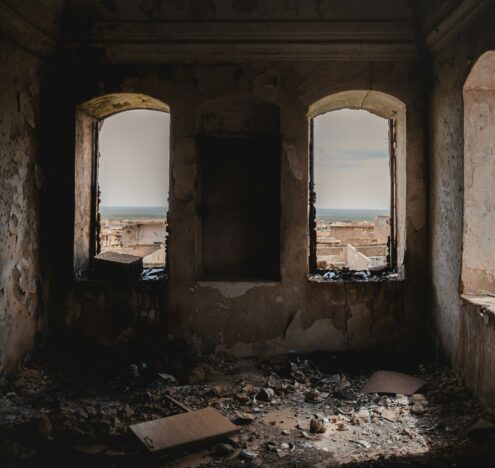As its thickness would suggest, “Infinite Jest” is about many things. Addiction, entertainment, and junior tennis all have entries in David Foster Wallace’s encyclopedic novel. Set in the first decade of the 21st century, “Infinite Jest” unfolds against a backdrop of political and ecological upheaval.
In a declaration of interdependence, the United States, Canada, and Mexico have formed the Organization of North American Nations (O.N.A.N.), in the process reducing the US’s neighbors to “post-millennial American protectorates.” At the same time, New England has become an irradiated hellscape, a land of green sunsets, violet rivers, and outsized feral infants.
With its vision of nationalism and commercialism run amok, “Infinite Jest” is a useful lens with which to examine the environmental security studies agenda. This includes the origins of the movement to securitize the environment, the relationship of the state to environmental degradation, the pathways that link such degradation to conflict, and the nature of scarcity in the 21st century.
The Environment as Threat
In many ways, “Infinite Jest” ’s engagement with environmental security is a product of timing. Wallace began work on the novel in 1991. By year’s end, the Soviet Union had collapsed, and America, now the sole superpower, found the world seemingly emptied of military threats.
But Cold War victory brought a certain loss of purpose for the US defense establishment. The study of environmental degradation thus became “increasingly popular among national security experts and organizations looking for new missions,” according to American political scientist Daniel Deudney. In 1994, as Wallace was refining a working draft of “Infinite Jest,” Robert Kaplan published his much-read article “The Coming Anarchy,” in which he identified the environment as “the national-security issue of the early 21st century.”
Whether or not he read Kaplan’s article, Wallace was clearly attuned to the environmental and geopolitical anxieties of turn-of-the-millennium America, described in the novel as “a dark time when all landfills got full and all grapes were raisins and sometimes in some places the falling rain clunked instead of splatted, and also, recall, a post-Soviet and -Jihad era when — somehow even worse — there was no real Foreign Menace of any real unified potency to hate and fear.”
Peace and Pollution
In depicting an America as demoralized by peace as it is by pollution, “Infinite Jest” echoes those scholars who argue that the rhetoric of environmental security is itself a threat to peace. Deudney, for example, warns that declaring “a ‘war on pollution’ is a dangerous and probably self-defeating enterprise.”
In “Infinite Jest,” this warning is borne out by the election of Johnny Gentle, “founding standard-bearer of the new ‘Clean U.S. Party,’ the strange-seeming but politically prescient annular agnation of ultra-right jingoist hunt-deer-with-automatic-weapons types and far-left macrobiotic Save-the-Ozone, -Rain-Forests, -Whales, -Spotted-Owl-and-High-pH-Waterways ponytailed granola-crunchers.”
With his insistence that “Someone is to blame” for America’s malaise, Gentle merges nationalist and environmentalist rhetoric, what Deudney calls “harnessing the old horse of national security to pull the heavy new environmental wagon.” In doing so, the lounge singer turned president sets the US on course for bloodshed.
Waste and the State
Much of the environmental security literature focuses on the purported link between environmental degradation and armed conflict. For instance, it is not hard to imagine violence resulting from a situation “in which country A dumps an intolerable amount of pollution on a neighboring country B … causing country B to attempt to pressure and coerce country A into eliminating its offending pollution.”
In fact, this neatly summarizes the environmental crime that defines US-Canada relations in “Infinite Jest.”
In a bid to achieve energy independence, the United States of “Infinite Jest” transitions to “cold annular fusion,” a cyclical process that relies on the production and subsequent consumption of vast quantities of toxic waste.
Much of the environmental security literature focuses on the purported link between environmental degradation and armed conflict.
However, the US must first navigate “the stage where they had the generating-massive-amounts-of-high-R-waste part down a lot more pat than the consuming-the-waste-in-a-nuclear-process-whose-own-waste-was-fuel-for-the-first-waste-intensive-phase-of-the-circle-of-reactions part.”
The Gentle administration disposes of this waste through a secret dumping campaign, in the process transforming the northeastern US into “barbed-wire landfills and fly-shrouded dumps and saprogenic magenta-fogged toxic-disposal sites.”
“A Tighter, Tidier Nation”
The president must now find a way to square his actions with his campaign pledge to create a “Tighter, Tidier Nation.” The solution: Territorial Reconfiguration. In an act of “ecological gerrymandering,” the US strong-arms Canada into accepting “the whole benighted smirch of ground,” resulting in a reconfigured US-Canada border that “looks sort of like some person or persons have taken a deep wicked canine-intensive bite out of its upper right bit.”
Canadian territory now extends as far south as Salem, Massachusetts, resulting in a geographic bulge dubbed the “Great Concavity” (or, as Canadians prefer, the “Great Convexity”).
“Taken to an absurd extreme,” writes Deudney, “seeing environmental degradation in a neighboring country as a national security threat could trigger various types of interventions, a new imperialism of the strong against the weak.”
“Infinite Jest” goes one step further: instead of environmental imperialism, we have an “Experialist” United States that forcibly donates its own territory, that lines its border with giant fans in order to “hold off the drooling and piss-colored bank of teratogenic Concavity clouds and move the bank well back, north, away.” In willfully shrinking its own borders, the United States of Wallace’s novel rejects Deudney’s claim that “[t]here is nothing about the problem of environmental degradation which is particularly ‘national’ in character.”
“An Intolerable Blow”
The Gentle administration soon discovers that its Experialist “gift” has had the unintended consequence of uniting the various anti-O.N.A.N. and Québécois separatist groups that populate “Infinite Jest.” These groups, which begin launching cross-border raids against the US, are listed and categorized in the novel as follows:
(Q=Québecois, E=Environmental, S=Separatist, V=Violent, VV=Extremely Violent)
—Les Assassins des Fauteuils Rollents (Q, S, VV)
—Le Bloc Québécois (Q, S, E)
—Calgarian Pro-Canadian Phalanx (E, V)
—Les Fils de Montcalm (Q, E)
—Les Fils de Papineau (Q, S, V)
—Le Front de la Libération de la Québec (Q, S, VV)
—Le Parti Québécois (Q, S, E)
As seen here, the Canadian terrorist groups in “Infinite Jest” are driven by a combination of environmental grievance, “ultra-right” nationalism, and Québécois separatism. The most fearsome of these groups, Les Assassins des Fauteuils Rollents (A.F.R.), hails from a part of Québec where, thanks to American pollution, residents must endure “chloracne and tremors and olfactory hallucinations and infants born with just one eye in the middle of their forehead.”
While real-world Québec is considerably better off, Colin Kahl, recent US under secretary of defense for policy, has argued that individuals impoverished by environmental degradation are indeed more likely to support insurgents or join guerilla groups. The activities of the A.F.R. also align with the scholarly consensus that environmental conflict is, as Canadian political scientist Thomas Homer-Dixon put it, primarily “sub-national, persistent, and diffuse.”
Scarcity and Abundance
One of the most enduring debates in environmental security concerns the relationship between resource scarcity and human conflict. Roughly two centuries before the publication of “Infinite Jest,” Thomas Malthus argued that human populations naturally outgrow their food supplies, resulting in “war[s] of extermination, sickly seasons, epidemics, pestilence, and plague.”
This theme was later taken up by Garrett Hardin, an American ecologist whose writings on overpopulation advocated anti-immigration and anti–famine aid policies. In the 1960s, Hardin articulated what he dubbed “the tragedy of the commons,” whereby individuals, acting rationally and in their own self-interest, proceed to destroy the very ecosystems they rely on for survival.
Not long thereafter, economist Julian Simon pushed back against these so-called doomsters, arguing that scarcity is in fact its own solution: by raising prices and incentivizing innovation, resource shortages “usually leave humanity better off in the long run than if the problems had never arisen.” With his conviction that problems tend to solve themselves, one can imagine Simon fitting in quite nicely on President Gentle’s cabinet.
Year of the Whopper
In order to meet the costs of Reconfiguration, the United States of “Infinite Jest” doubles down on consumerism, in part by reinventing the calendar. Under President Gentle, years are no longer numbered, they’re sponsored: Year of the Whopper, Year of the Trial-Size Dove Bar, Year of the Whisper-Quiet Maytag Dishmaster. In this we can see traces of a Simon-esque rationale, a belief in the power of consumption to produce its own solutions.
Looking past the feral hamsters and waste-disposal catapults, what we find is a story that feels all too real, a story of degradation and demagoguery, of simmering resentment and spasmodic conflict.
The same holds for the Gentle administration’s energy policy. If we choose, as Simon does, to measure human progress by “richness of consumption,” then the advent of annular fusion may well appear a triumph — until we account for Wallace’s sense of irony, that is.
Though it satisfies America’s energy needs, annular fusion turns out to be so efficient, so good at sucking toxins out of the environment, that the Great Concavity becomes “annularly overfertilized,” a hyper-wilderness beset by “rapacial feral hamsters and insects of Volkswagen size and infantile giganticism and … unmacheteable regions of forests.”
As a result, the US finds itself “need[ing] to keep steadily dumping in toxins to keep the uninhibited ecosystem from spreading and overrunning more ecologically stable areas.” To Simon’s argument that short-term scarcity leads to long-term abundance, “Infinite Jest” responds with the specter of self-perpetuating consumption, of abundance multiplied, like a cancer, beyond all natural constraint.
Concavity, Convexity, Convergence
“Infinite Jest” does not end, at least not in the traditional sense. As Wallace himself explained, “Certain kind[s] of parallel lines are supposed to start converging in such a way that an ‘end’ can be projected by the reader somewhere beyond the right frame.”
But where does “Infinite Jest” converge with real-world environmental security studies? Looking past the feral hamsters and waste-disposal catapults, what we find is a story that feels all too real, a story of degradation and demagoguery, of simmering resentment and spasmodic conflict.
At the same time, “Infinite Jest” recognizes that environmental concerns do not by themselves drive societies to violence. Indeed, by the novel’s end, environmental grievance is revealed as something of a red herring, a cover story the A.F.R. has adopted as it pursues the decidedly political goal of Québécois separatism.
Therefore, despite the novel’s staunchly pro-environmental themes, “the threshold of violence” that Wallace presents, to borrow Günther Baechler’s words, “definitely depends on sociopolitical factors and not on the degree of environmental degradation as such.” Wallace’s lasting genius is that he can teach such sober lessons, not despite his manic imagination but because of it.





















